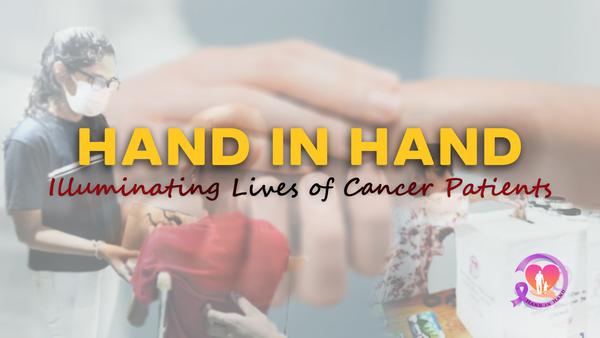Let's fight against Cancer: Types of Cancer - Lung cancer
How common is lung cancer?
According to the World Health Organization, Lung cancer is the most common type of cancer (2.09 million cases) in the world in 2018 and it has the highest number of cancer deaths (1.76 million deaths).
According to the National Cancer Registry of Sri Lanka, lung cancer is the second most common cancer among men (1065 lung cases in 2018) and another most common cancer among Sri Lankans (1447 lung cases in 2018).
Lung Cancer awareness ribbon color: White
Lung Cancer awareness month: November
What is Lung cancer?
Lung cancer is a type of cancer that begins in the lungs. Lung cancer occurs when abnormal cells in the lungs go out of control. This type of cancer can begin anywhere in the lungs and affect any part of the respiratory system. These abnormal cells can spread to the lymph nodes and other parts of the body.
Types of Lung cancer:
Non-small cell lung cancer (NSCLC)
About 85% of lung cancers are NSCLC. The main subtypes of NSCLC are adenocarcinoma, squamous cell carcinoma, and large cell carcinoma. These subtypes, which begin with different types of lung cells are grouped as NSCLC because their treatment and outlook are often the same.
Adenocarcinoma: Adenocarcinoma begins with cells that secrete mucus-like fluid.
This type of lung cancer is mainly found in current or former smokers, but it is also more common in non-smokers. Adenocarcinoma is more common in women than men and the risk of developing this cancer is higher in younger people. Adenocarcinoma is usually found on the outside of the lungs and is more likely to be detected before it spreads.
Squamous cell carcinoma: Square cell carcinoma begins with squamous cells, which are flat cells that line the air inside the lungs. They are often associated with a history of smoking and are found near the main airway (bronchus) in the central part of the lungs.
Large cell carcinoma : This can occur in any part of the lung. It tends to grow and spread quickly. Therefore, it is difficult to treat. Large-cell neuroendocrine carcinoma is a subtype of large-cell carcinoma and that grows very rapidly and this is very similar to small-cell lung cancer.
Small cell lung cancer (SCLC)
About 10% to 15% of all lung cancers are SCLC, sometimes called oat cell carcinoma. This type of lung cancer grows and spreads rapidly than NSCLC. The dangerous aspect here is that about 70% of SCLC patients will have cancer that has already spread at the time they are diagnosed. As the cancer grows quickly, it responds well to chemotherapy and radiation treatments. Unfortunately, for many patients, the cancer will return at some point.
Other types of lung tumors
Lung carcinoid tumors: This type of lung cancer is very rarely (less than 5% of lung cancers) and most of these grow slowly.
Symptoms of lung cancer
· A cough that does not go away or gets worse
· Coughing up blood
· Loss of appetite
· Unexplained weight loss
· Shortness of breath
· Chest pain that is often worse with deep breathing, coughing, or laughing
· New onset of wheezing
· Feeling tired or weak
· Infections such as bronchitis and pneumonia that don’t go away or keep coming back
If lung cancer spreads to other parts of the body, it can cause:
· Bone pain (such as back or hip pain)
· Changes in the nervous system (such as headache, weakness or numbness of the arm or leg, dizziness, balance problems or seizures), from cancer spread to the brain
· Yellowing of the skin and eyes (jaundice), from spread cancer to liver
Causes of Lung cancer
· Smoking tobacco - this is the leading cause of lung cancer. About 80% of lung cancer deaths are caused by smoking.
· Exposure to secondhand smoke
· Previous radiation therapy
· Exposure to radon gas
· Workplace exposures to asbestos, diesel exhaust or certain other chemicals
· Family history of lung cancer
Lung cancer mainly occurs in older people. Overall, it can affect both smokers and non-smokers. The risk is much higher for smokers and lower for non-smokers.
First stage lung cancer can be highly cured. Usually, doctor will need to surgically remove the cancer. patient may need chemotherapy or radiation therapy if he have symptoms of cancer or are likely to stay.
Note that: It is more important than ever to stay healthy after lung cancer treatment. Quitting smoking and eating healthy food can help reduce your risk of recurrence of lung cancer and protect you from other health problems.
පෙනහළු පිළිකා කෙතරම් බහුලද?
ලෝක සෞඛ්ය සංවිධානයට අනුව, පෙනහළු පිළිකා 2018 දී ලෝකයේ බහුලව දක්නට ලැබෙන පිළිකා වර්ගය (රෝගීන් මිලියන 2.09) වන අතර පිළිකා අතරින් වැඩිම පිළිකා මරණ සංඛ්යාවක් මෙමගින් (මරණ මිලියන 1.76) සිදුවී ඇත.
ශ්රී ලංකාවේ ජාතික පිළිකා ලේඛනයේ දත්ත වලට අනුව, පිරිමින් අතර දෙවන පොදු පිළිකාව වන්නේ පෙනහළු පිළිකා (2018 දී පෙනහළු රෝගීන් 1065 ක්) සහ මෙය ශ්රී ලාංකිකයන් අතර බහුලව දක්නට ලැබෙන තවත් පිළිකා වර්ගයකි (2018 දී පෙනහළු රෝගීන් 1447 ක්).
පෙනහළු පිළිකාව පිලිබද දැනුවත් කිරීමේ වර්ණය: සුදු
පෙනහළු පිළිකාව පිලිබද දැනුවත් කිරීමේ මාසය: නොවැම්බර්
පෙනහළු පිළිකා යනු කුමක්ද?
පෙනහළු පිළිකා යනු පෙනහළු වලින් ආරම්භ වන පිළිකා වර්ගයකි. පෙනහළු පිළිකා ඇතිවන්නේ පෙනහළු වල අසාමාන්ය සෛල පාලනයෙන් තොර වූ විටය. මෙම පිළිකා වර්ගය පෙනහළු වල ඕනෑම තැනක ආරම්භ විය හැකි අතර ශ්වසන පද්ධතියේ ඕනෑම කොටසකට බලපායි. පිළිකා සෛල, වසා ගැටිති හා ශරීරයේ අනෙකුත් කොටස් වලට පැතිර යා හැකිය.
පෙනහළු පිළිකා වර්ග:
කුඩා නොවන සෛල පෙනහළු පිළිකා (NSCLC)
පෙනහළු පිළිකා වලින් 80% සිට 85% දක්වා ප්රමාණයක් NSCLC වේ. NSCLC හි ප්රධාන උප ප්රභේද වන්නේ ඇඩිනොකාර්සිනෝමා, චතුරස්රාකාර සෛල පිළිකා සහ විශාල සෛල පිළිකා ය. විවිධ වර්ගයේ පෙනහළු සෛල වලින් ආරම්භ වන මෙම උප වර්ගයන් NSCLC ලෙස කාණ්ඩගත කර ඇත්තේ ඒවායේ ප්රතිකාර හා දෘෂ්ටිය බොහෝ විට සමාන වන බැවිනි.
ඇඩිනොකාර්සිනෝමා: ඇඩිනොකාර්සිනෝමා සෛල වලින් ආරම්භ වන අතර ශ්ලේෂ්මල වැනි තරලය ස්රාවය කරයි. මෙම වර්ගයේ පෙනහළු පිළිකා ප්රධාන වශයෙන් වර්තමාන හෝ කලින් දුම් පානය කරන්නන් තුළ දක්නට ලැබේ, නමුත් එය දුම් නොබොන්නන් තුළද බහුලව දක්නට ලැබේ. ඇඩිනොකාර්සිනෝමා පිරිමින්ට වඩා කාන්තාවන් තුළ බහුලව දක්නට ලැබෙන අතර තරුණ තරුණියන් තුළ මෙම පිළිකාව වැළඳීමේ අවදානම පවතී. ඇඩිනොකාර්සිනෝමා සාමාන්යයෙන් පෙනහළු වල පිටත දක්නට ලැබෙන අතර එය පැතිරීමට පෙර හඳුනා ගැනීමට වැඩි ඉඩක් ඇත.
චතුරස්රාකාර සෛල පිළිකා: චතුරස්රාකාර සෛල පිළිකා ආරම්භ වන්නේ චතුරස්රාකාර සෛල වලිනි. ඒවා පැතලි සෛල වන අතර එය පෙණහලුවල වාතයේ ඇතුළත රේඛා කරයි. ඒවා බොහෝ විට දුම්පානය පිළිබඳ ඉතිහාසයකට සම්බන්ධ වී ඇති අතර පෙණහලු වල මධ්යම කොටසෙහි ප්රධාන ගුවන් මාර්ගයක් (bronchus) අසල දක්නට ලැබේ.
විශාල සෛල පිළිකා: පෙනහළු වල ඕනෑම කොටසක මෙය සිදුවිය හැකිය. එය ඉක්මනින් වර්ධනය වීමට හා පැතිරීමට නැඹුරු වේ. එබැවින් ප්රතිකාර කිරීම දුෂ්කර ය. විශාල සෛල නියුරෝ එන්ඩොක්රීන් පිළිකා යනු විශාල සෛල පිළිකා වල උප ප්රභේදයක් වන අතර එය ඉතා වේගයෙන් වර්ධනය වන අතර මෙය කුඩා සෛල පෙනහළු පිළිකාවට බෙහෙවින් සමාන වේ.
කුඩා සෛල පෙනහළු පිළිකා (SCLC)
සියළුම පෙනහළු පිළිකා වලින් 10% සිට 15% දක්වා ප්රමාණයක් SCLC වන අතර සමහර විට එය ඕට් සෛල පිළිකා ලෙසද හැඳින්වේ. මෙම වර්ගයේ පෙනහළු පිළිකා එන්එස්සීඑල්සී වලට වඩා වේගයෙන් වර්ධනය වේ. මෙහි ඇති භයානක කරුණ නම්, SCLC රෝගීන්ගෙන් 70% කට පමණ පිළිකා ඇති බව හඳුනා ගන්නා අවස්ථාවේ දී දැනටමත් පැතිරී ඇති බවයි. පිළිකාව ඉක්මනින් වර්ධනය වන විට, එය රසායනික චිකිත්සාව සහ විකිරණ ප්රතිකාර සඳහා හොඳින් ප්රතිචාර දක්වයි. අවාසනාවකට මෙන්, බොහෝ රෝගීන් සඳහා, පිළිකාව යම් අවස්ථාවක දී නැවත පැමිණේ.
වෙනත් වර්ගවල පෙනහළු පිළිකා
පෙනහළුපිළිකා කාරක පිළිකා: මෙම වර්ගයේ පෙනහළු පිළිකා දුර්ලභය (පෙනහළු පිළිකා වලින් 5% ට වඩා අඩුය). මේවායින් බොහොමයක් සෙමින් වර්ධනය වේ.
පෙනහළු පිළිකා රෝග ලක්ෂණ
· කැස්ස පහව නොයාම හෝ නරක අතට හැරේ
· කැස්ස සමග රුධිරය යාම
· ආහාර රුචිය නැතිවීම
· පැහැදිලි කළ නොහැකි බර අඩු වීම
· හුස්ම හිරවීම
· ගැඹුරු හුස්ම ගැනීම, කැස්ස හෝ සිනාසීම සමඟ බොහෝ විට නරක අතට හැරෙන පපුවේ වේදනාව
· හුස්ම හිරවීමේ නව ආරම්භය
· වෙහෙස හෝ දුර්වල බවක් දැනේ
· බ්රොන්කයිටිස් සහ නියුමෝනියාව වැනි ආසාදන ඉවත්ව නොයනු ඇත
පෙනහළු පිළිකා ශරීරයේ අනෙකුත් කොටස් වලට පැතිරෙන්නේ නම්, එය හේතු විය හැක රෝග ලක්ෂණ:
· අස්ථි වේදනාව (පිටුපස හෝ ඉණෙහි වේදනාව වැනි)
· ස්නායු පද්ධතියේ වෙනස්වීම් (හිසරදය, දුර්වලතාවය හෝ අතක් හෝ කකුලක් හිරිවැටීම, කරකැවිල්ල, සමබරතා ගැටළු හෝ අල්ලා ගැනීම් වැනි) පිළිකාව මොළය දක්වා පැතිරීම
· සමේ සහ ඇස්වල කහ පැහැය (සෙංගමාලය), පිළිකාව අක්මාව දක්වා පැතිරීම
පෙනහළු පිළිකා ඇතිවීමට හේතු
· දුම්කොළ දුම්පානය - පෙනහළු පිළිකා ඇතිවීමට ප්රධාන හේතුව මෙයයි. පෙනහළු පිළිකා මරණ වලින් 80% ක් පමණ සිදුවන්නේ දුම්පානයෙනි.
· දුම්කොළ දුමාරයට නිරාවරණය වීම
· පෙර විකිරණ චිකිත්සාව
· රේඩෝන් වායුවට නිරාවරණය වීම
· සේවා ස්ථාන ඇස්බැස්ටෝස්, ඩීසල් පිටාර හෝ වෙනත් රසායනික ද්රව්යවලට නිරාවරණය වීම
· පෙනහළු පිළිකා පිළිබඳ පවුල් ඉතිහාසය
පෙනහළු පිළිකා ප්රධාන වශයෙන් වයස්ගත පුද්ගලයින් තුළ දක්නට ලැබේ. සමස්තයක් වශයෙන්, දුම් පානය කරන්නන් සහ දුම් නොබොන්නන් යන දෙපිරසටම වැලදිය හැක. දුම් පානය කරන්නන් සඳහා අවදානම බෙහෙවින් වැඩි වන අතර දුම් නොබොන්නන් සඳහා අවදානම අඩුය.
පළමු අදියරේදී පෙනහළු පිළිකා බොහෝ විට සුව කළ හැකිය. සාමාන්යයෙන් වෛද්යවරයාට පිළිකාව ශල්යකර්මයෙන් ඉවත් කිරීමට අවශ්ය වනු ඇත. එමෙන්ම තවමත් රෝගියාට පිළිකා රෝග ලක්ෂණ ඇත්නම් ඔහුට රසායනික හෝ විකිරණ ප්රතිකාර අවශ්ය වේ.
සටහන: පෙනහළු පිළිකා ප්රතිකාරයෙන් පසු නිරෝගීව සිටීම වෙන කවරදාටත් වඩා වැදගත් ය. දුම්පානය නතර කිරීම සහ සෞඛ්ය සම්පන්න ආහාර අනුභව කිරීම පෙනහළු පිළිකා නැවත ඇතිවීමේ අවදානම අවම කර ගැනීමට සහ වෙනත් සෞඛ්ය ගැටළු වලින් ඔබව ආරක්ෂා කිරීමට උපකාරී වේ.
Check out our other blogs on cancer;
1) What is cancer: https://blog.rotaractmora.org/what-is-cancer/
2) What causes cancer: http://blog.rotaractmora.org/causes-of-cancer/
3) Childhood cancer: http://blog.rotaractmora.org/fight-against-cancer/
4) Leukemia: https://blog.rotaractmora.org/hih-cancer-leukemia/
5) Brain cancer: https://blog.rotaractmora.org/brain-cancer/
6) Lung cancer: https://blog.rotaractmora.org/lung-cancer/
7) Breast cancer: https://blog.rotaractmora.org/breast-cancer/
8) Skin cancer: http://blog.rotaractmora.org/skin-cancer/
9) Oral cancer: https://blog.rotaractmora.org/oral-cancer/
10) Thyroid cancer: https://blog.rotaractmora.org/thyroid-cancer-2/
11) Movie review- The fault in our stars: https://blog.rotaractmora.org/movie-review-the-fault-in-our-stars/
12) Cervical cancer: http://blog.rotaractmora.org/cervical-cancer/
13) Colorectal cancer: http://blog.rotaractmora.org/colorectal-cancer/
14) Movie review: My life without me: http://blog.rotaractmora.org/moviereviewmylifewithoutme/
15) Cancer health policy of WHO: http://blog.rotaractmora.org/health-policy-of-who/



